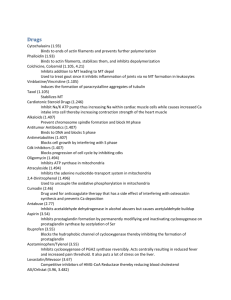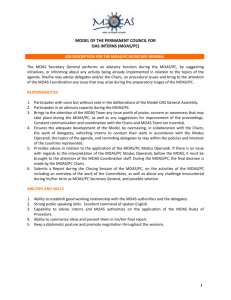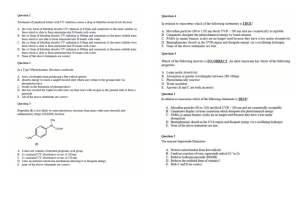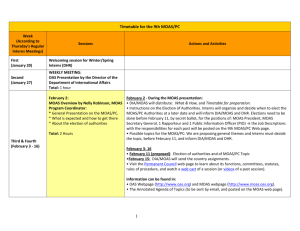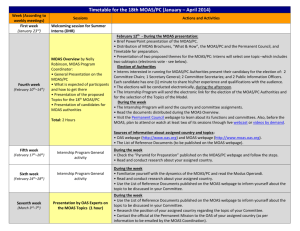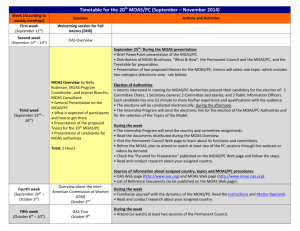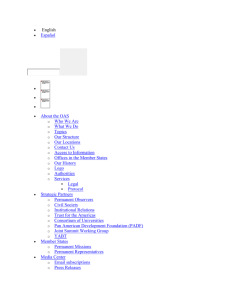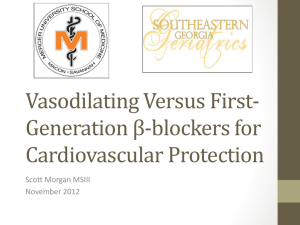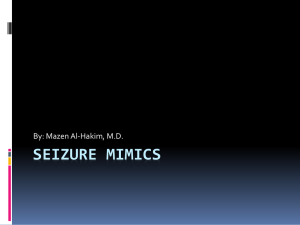IFN-b: MOAs - Projects In Knowledge
advertisement
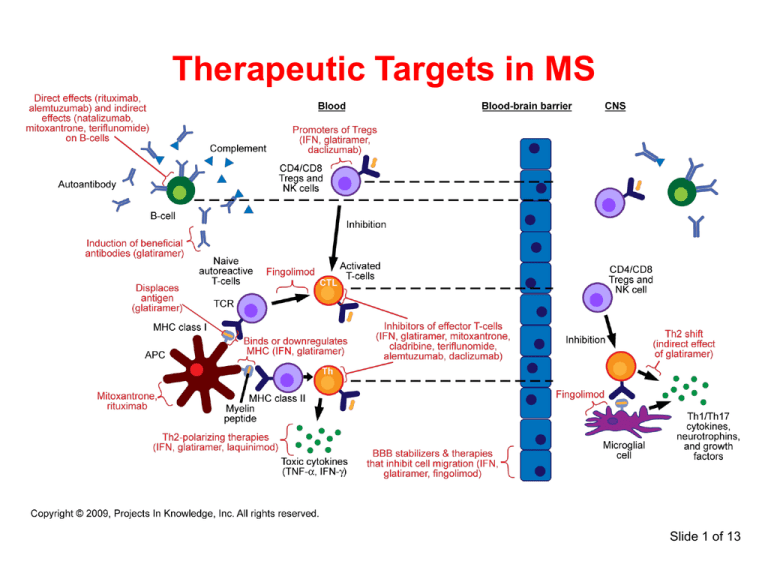
Therapeutic Targets in MS Slide 1 of 13 MOAs for Interferon Beta • Inhibits antigen presentation and downregulates major histocompatibility complex (MHC) and costimulatory molecules1-4 • Inhibits T-cell (and other cell) stimulation and proliferation1 • Restores normal suppressor function1 • Shifts cytokines – Downregulates proinflammatory cytokines (eg, IL-2, IL-12, IL-13, IFN-gamma, TNF-alpha) and inhibits their production1-3,5,6 – Promotes Th2 cytokines (eg, IL-4, IL-10)1,2,5 Slide 2 of 13 MOAs for Interferon Beta • Stabilizes blood-brain barrier – May alter adhesion molecule expression and T-cell adhesion to blood-brain barrier3,4,7 – Inhibits matrix metalloproteinase (MMP) production and MMP’s effects on blood-brain barrier permeability1,2,4,8 – Upregulates CD73 on endothelial cells, which inhibits CD4+ cell transmigration into parenchyma9 Slide 3 of 13 MOAs for Glatiramer Acetate • Binds to class I and II MHC10-12 • Competes with and displaces antigen, eg, myelin basic protein (MBP), from MHC11,13 • May be T-cell receptor antagonist of MBP (controversial)14 • Inhibits MBP reactivity at level of cytokine secretion15 but not proliferation16,17 (frequency of this is not certain) • Shifts cytokines – Modulates antigen-presenting cells, which influences T-cells toward Th218,19 – Promotes Th1 to Th2 shift in periphery19-21 – Promotes Th2 cells that secrete anti-inflammatory cytokines and neurotrophic factors in CNS13 Slide 4 of 13 MOAs for Glatiramer Acetate • Modulates other functions of monocytes13 • Upregulates CD8+ cells (Tregs)12,22 • Restores Treg cell function, including CD4+CD25+FoxP3+ Tregs19 • Promotes secretion of brain-derived neurotrophic factor and other growth factors and cytokines13,23 • Downregulates chemokine receptors that help draw Th1 cells to sites of inflammation24 • Induces clonal anergy and/or clonal deletion via apoptosis of CD4+ T-cells25-27 • Induces antiglatiramer antibodies that may promote remyelination and do not diminish glatiramer efficacy28 Slide 5 of 13 MOAs for Natalizumab • Binds to a4b1 and a4b7 integrins expressed on leukocytes29 – Inhibits binding to ligands (VCAM-1 and MAdCAM-1) on vascular endothelial cells, reducing migration of these cells into CNS29 – Preferentially inhibits effector T-cells, not Tregs30 • Inhibits leukocyte inflammatory activity and recruitment of activated immune cells, as a result of inhibiting integrin/CAM binding29 • Affects B-cell production or migration30 • Has downstream effects on gene regulation31 Slide 6 of 13 MOAs for Mitoxantrone • Intercalates into DNA through hydrogen binding causing crosslinks and strand breaks32 • Interferes with RNA32 • Inhibits topoisomerase II (which uncoils and repairs damaged DNA)32 • Has cytocidal effects on proliferating and nonproliferating cells32 – Decreases proliferation and functions of T-cells, B-cells, and macrophages, including proinflammatory cytokine secretion32,33 – Induces apoptosis of antigen-presenting cells33 – Inhibits macrophage-mediated myelin degradation34 – Decreases CXCR235 – Increases number of naive CD8+ cells36 Slide 7 of 13 MOAs for Rituximab • Targets anti-CD20 surface molecule on B-cells and some immature B-cells (not on plasma cells)37 – Reduces B-cell numbers in periphery and CSF37 – May eventually reduce plasma cells38 and Ig39 – Inhibition of B-cell functions unrelated to function of plasmablasts and plasma cells40 Antigen presentation Cytokine secretion Apparent effect on blood-brain barrier Slide 8 of 13 MOAs of Investigational Therapies in MS • Cladribine: antimetabolite; reduces number of T-cells; some preferential effect on CD4+ cells41 • Laquinimod: uncertain, but some effect on Th1 to Th2 shift42 • Teriflunomide: antimetabolite; inhibits pyrimidine synthesis43 • Fingolimod: agonist and perhaps indirect antagonist of S1P1 and related receptors on inflammatory cells44 – Prevents emigration from secondary lymphoid organs44 – Receptors are also on neurons, glia, and vascular cells44 Slide 9 of 13 MOAs of Investigational Monoclonal Antibodies • Alemtuzumab – Binds to CD52 surface molecule on T-cells, B-cells, monocytes, and eosinophils37 – Induces cell death37 • Daclizumab – Binds to IL-2Ra CD25) which is upregulated on activated and autoreactive T-cells37 but also highly expressed on Tregs (eg, CD4+CD25+FoxP3+Tregs) – Increases CD56 NK cells (which have immunoregulatory functions)37 Slide 10 of 13 References 1. Markowitz CE. Neurology. 2007;68(suppl 4):S8-S11. 2. Dhib-Jalbut S. Neurology. 2002;58:S3-S9. 3. Yong VW, et al. Neurology. 1998;51:682-689. 4. Yong VW. Neurology. 2002;59:802-808. 5. Chabot S, et al. Neurology. 2000;55:1497-1505. 6. Wang X, et al. J Immunol. 2000;165:548-557. 7. Graber J, et al. J Neuroimmunol. 2005;161:169-176. 8. Stüve O, et al. Ann Neurol. 1996;40:853-863. 9. Niemela J, et al. Eur J Immunol. 2008;38:2718-2726. 10. Arnon R, et al. PNAS. 2004;101:14593-14598. 11. Fridkis-Hareli M, et al. PNAS. 1994;91:4872-4876. 12. Karandikar NJ, et al. J Clin Invest. 2002;109:641-649. 13. Ruggieri M, et al. CNS Drug Rev. 2007;13:178-191. 14. Aharoni R, et al. PNAS. 1999;96:634-639. Slide 11 of 13 References 15. Chen M, et al. J Neurol Sci. 2002;201:71-77. 16. Burns J, et al. Neurology. 1991;41:1317-1319. 17. Lisak RP, et al. J Neurol Sci. 1983;62:281-293. 18. Vieira PL, et al. J Immunol. 2003;170:4483-4488. 19. Weber MS, et al. Neurotherapeutics. 2007;4:647-653. 20. Arnon R, et al. PNAS. 2004;101(suppl 2):14593-14598. 21. Chen M, et al. Mult Scler. 2001;7:209-219. 22. Tennakoon DK, et al. J Immunol. 2006;176:7119-7129. 23. Ziemssen T, et al. Brain. 2002;125(Pt 11):2381-2391. 24. Allie R, et al. Arch Neurol. 2005;62:889-894. 25. Ziemssen T, et al. Int Rev Neurobiol. 2007;79:537-570. 26. Gran B, et al. Neurology. 2000;55:1704-1714. 27. Ragheb S, et al. Mult Scler. 2001;7:43-47. 28. Ure DR, et al. FASB J. 2002;16:1260-1262. 29. Tysabri [PI]. Cambridge, MA: Biogen Idec; 2008. Slide 12 of 13 References 30. Krimbholz M, et al. Neurology. 2008;71:1350-1354. 31. Lindberg RLP, et al. J Neuroimmunol. 2008;194:153-164. 32. Novantrone [PI]. Melville, NY: OSI Pharmaceuticals; 2008. 33. Fox EJ. Neurology. 2004;63(suppl 6):S15-S18. 34. Watson CM, etal. Int J Immunopharmacol. 1991;13:923-930. 35. Bielecki B, et al. J Clin Immunol. 2008;28:122-130. 36. Pelfrey CM, et al. J Neuroimmunol. 2006;175:192-199. 37. Lutterotti A, et al. Lancet Neurol. 2008;7:538-547. 38. Petereit HF, et al. Acta Neurol Scand. 2008;117:399-403. 39. Teng YKO, et al. Arthritis Rheum. 2007;56:3909-3918. 40. McFarland HF. N Engl J Med. 2008;358:664-665. 41. Stelmasiak Z. ComtecMED Web site. http://www.comtecmed.com/CONY/2008/Uploads/assets/speakers%20abstracts/stelmasiak.pdf 42. Zou LP, et al. Neuropharmacology. 2002;42:731-739. 43. Cherwinski HM, et al. J Pharmacol Exp Ther. 1995;275:1043-1049. 44. Horga A, et al. Expert Rev Neurother. 2008;8:699-714. Slide 13 of 13

